Batman Forever
6.6 /10 3 Votes
41% Rotten Tomatoes Film series Batman Film Series Duration Language English | 5.4/10 IMDb 51% Metacritic Genre Action, Adventure, Fantasy Budget 100 million USD Country United States | |||||||||||||||||||||||||||||||||
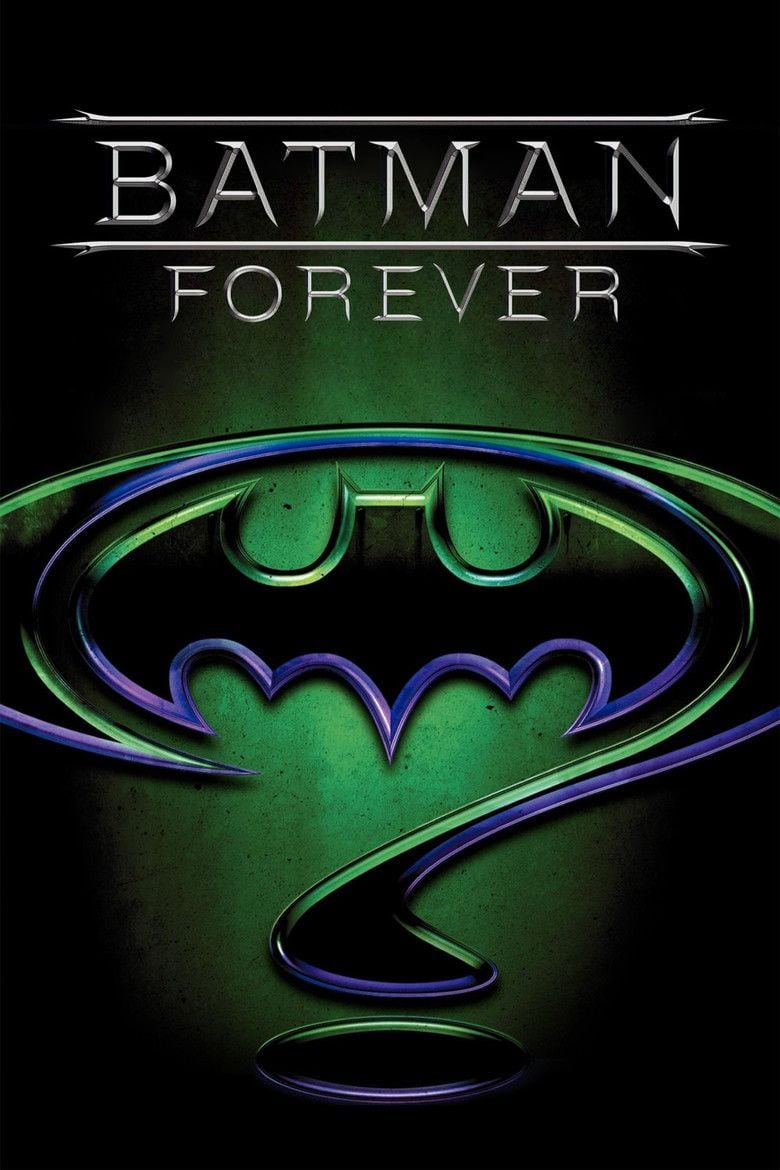 | ||||||||||||||||||||||||||||||||||
Release date June 16, 1995 (1995-06-16) (United States) Writer Bob Kane (characters), Lee Batchler (story), Janet Scott Batchler (story), Lee Batchler (screenplay), Janet Scott Batchler (screenplay), Akiva Goldsman (screenplay) Cast (Batman), (Two-Face/Harvey Dent), (Riddler/Edward Nygma), (Dr. Chase Meridian), (Robin/Dick Grayson), (Alfred Pennyworth) Similar movies The Dark Knight , Superman , Man of Steel , Batman v Superman: Dawn of Justice , The Dark Knight Rises , Tagline Courage now, truth always... | ||||||||||||||||||||||||||||||||||
Batman forever 1 10 movie clip batman goes out 1995 hd
Batman Forever is a 1995 American superhero film directed by Joel Schumacher and produced by Tim Burton, based on the DC Comics character Batman. It is the third installment of the initial Batman film series, with Val Kilmer replacing Michael Keaton as Bruce Wayne / Batman. The film stars Chris O'Donnell, Nicole Kidman, Tommy Lee Jones and Jim Carrey. The plot focuses on Batman trying to stop Two-Face (Jones) and the Riddler (Carrey) in their villainous scheme to extract confidential information from all the minds in Gotham City and use it to learn Batman's identity and bring the city under their control. He gains allegiance from a love interest—psychiatrist Dr. Chase Meridian (Kidman) and a young, orphaned circus acrobat named Dick Grayson (O'Donnell), who becomes his sidekick Robin.
Contents
- Batman forever 1 10 movie clip batman goes out 1995 hd
- Batman forever 3 10 movie clip chicks dig the car 1995 hd
- Plot
- Cast
- Development
- Filming
- Design and effects
- Music
- Deleted scenes
- Box office
- Critical reaction
- Accolades
- Merchandising
- Batman forever 9 10 movie clip batman and robin partner up 1995 hd
- Batman forever 5 10 movie clip superhero gig 1995 hd
- References

Batman Forever's tone is significantly different from the previous installments, becoming more family-friendly since Warner Bros. believed that the previous Batman film, Batman Returns (1992), failed to outgross its predecessor due to parent complaints about the film's violence and dark overtones. Schumacher eschewed the dark, dystopian atmosphere of Burton's films by drawing inspiration from the Batman comic book of the Dick Sprang era, as well as the 1960s television series. Keaton chose not to reprise the role due to Burton stepping down as director. William Baldwin and Ethan Hawke were initially considered for Keaton's replacement before Kilmer joined the cast. Coincidentally, Baldwin later starred as Batman in the DC Animated film, Justice League: Crisis on Two Earths.
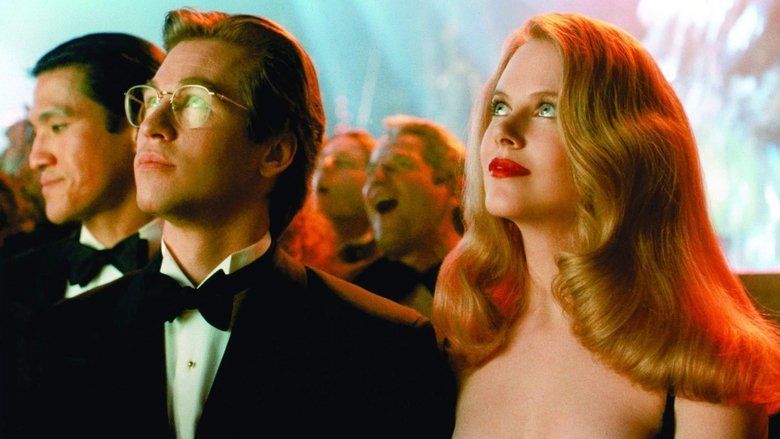
The film was released on June 16, 1995, receiving mixed reviews, but was a financial success. Batman Forever grossed over $336 million worldwide and became the sixth-highest-grossing film worldwide of 1995.
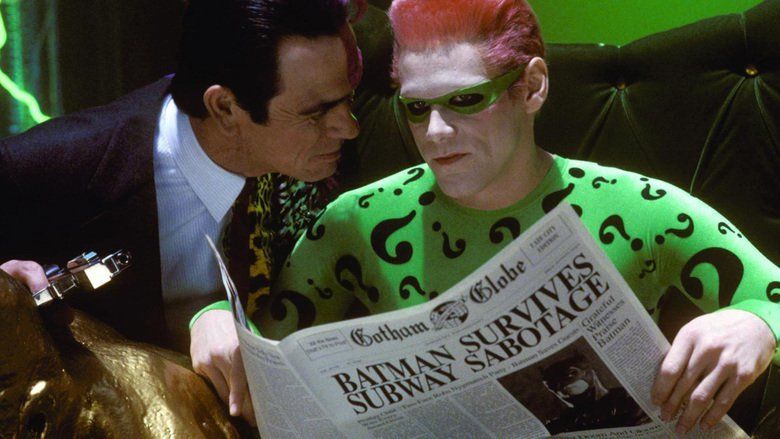
Batman forever 3 10 movie clip chicks dig the car 1995 hd
Plot
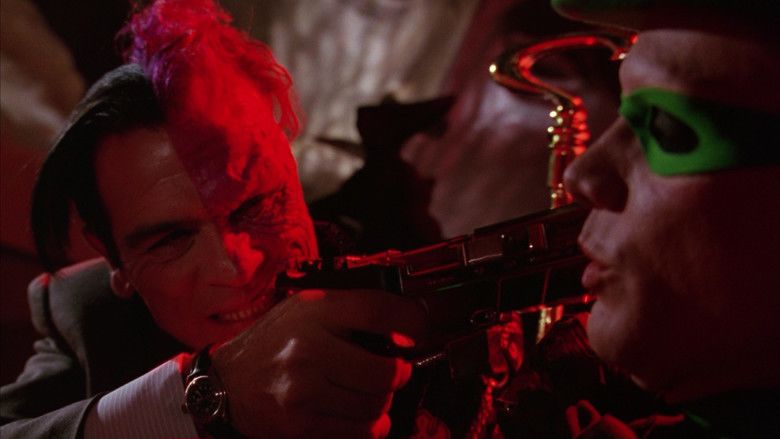
In Gotham City, some time after defeating the Penguin, the crime fighter Batman defuses a hostage situation caused by a criminal known as Two-Face, the alter ego of the former district attorney Harvey Dent, but Two-Face escapes and remains at large. Edward Nygma, a researcher at Wayne Enterprises who idolizes Bruce Wayne, has developed a device that can beam television into a person's brain. Bruce offers to let Nygma come up with schematics for the device and set up a meeting with his assistant. However, after Nygma demands an answer from him immediately, Bruce rejects the invention, believing it to be too close to mind manipulation. After killing his supervisor Fred Stickley, Nygma resigns and seeks retaliation against Bruce for rejecting his invention and begins to send him riddles (Nygma rigs the security cameras to record Stickley committing suicide, as well as a suicide note, which everybody believes but Bruce Wayne doubts this is the truth) A news report reveals how Harvey Dent became Two-Face: when he was prosecuting a mob boss named Sal Maroni, Maroni threw acid on Dent's face, disfiguring half of it. Batman tried to save him, but failed. After the incident, Dent seeks to kill Batman for failing to save him. Bruce meets Chase Meridian, a psychiatrist who is obsessed with Batman, and invites her to come with him to a circus event. After a performance from the circus performers, The Flying Graysons, Two-Face arrives and threatens to blow up the circus unless Batman comes forward and surrenders his life to him. The Flying Graysons attempt to stop Two-Face, but most of them get killed as a result. Only Dick Grayson, the youngest member, survives as he climbs to the roof and throws Two-Face's bomb into a river.
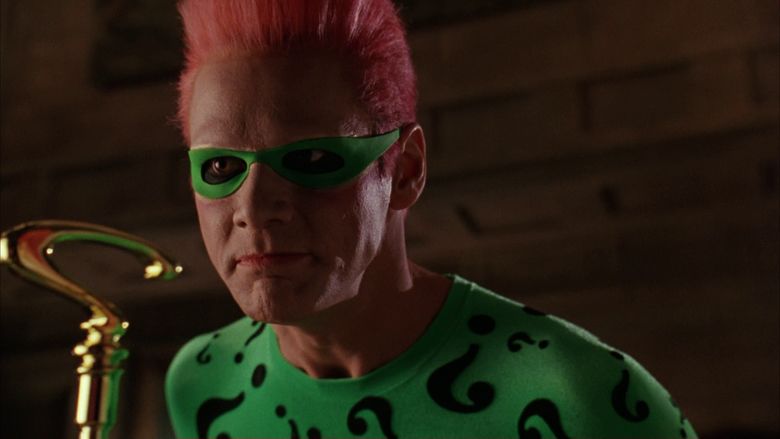
Bruce invites the orphaned Dick to stay at Wayne Manor. Dick, still troubled by the murder of his family, intends to kill Two-Face and avenge his family. When he discovers that Bruce is Batman, he demands that Bruce help him find Two-Face so that he can kill him, but Bruce refuses. Meanwhile, Nygma turns himself into a criminal called the Riddler and forms an alliance with Two-Face. The two steal capital in order to mass-produce Nygma's brainwave device. At Nygma's business party, Nygma discovers Bruce's alter ego using the brainwave device. Two-Face arrives and crashes the party. He nearly kills Batman, but Dick manages to save him. Meanwhile, Chase has fallen in love with Bruce, which surpasses her obsession with Batman, but she soon discovers that they are one and the same. Bruce decides to stop being Batman in order to have a normal life with Chase and to prevent Dick from murdering Two-Face. Dick angrily runs away while Bruce and Chase have dinner together in the manor. The Riddler and Two-Face arrive and attack Wayne Manor; in the process, the Riddler destroys the Batcave. The criminals kidnap Chase after Two-Face shoots Bruce and the Riddler leaves him an another riddle.
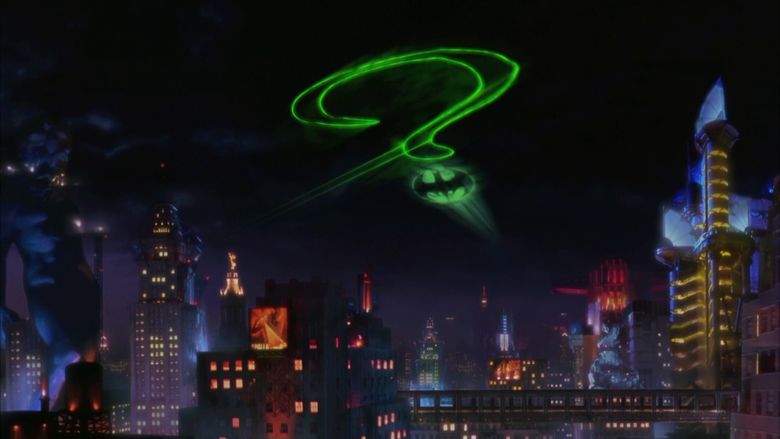
Using the riddles, Bruce and his butler, Alfred, deduce the Riddler's secret identity. Chase is imprisoned by The Riddler and Two-Face in their hideout. Dick returns and becomes Batman's sidekick, Robin, after realising that the Caped Crusader could use a hand. Batman and Robin head to Riddler and Two-Face's lair, Claw Island, where they are separated. Robin encounters Two-Face and nearly kills him, but realizing that he does not have it in him to murder, Robin spares him. Two-Face gets the upper hand and captures Robin. Batman arrives at the lair, where Robin and Chase are held as hostages. The Riddler gives Batman a chance to save only one hostage, but Batman destroys the Riddler's brainwave collecting device, causing the Riddler to suffer a mental breakdown. Batman then rescues both Robin and Chase. Two-Face corners the trio and determines their fate with the flip of a coin, but Batman throws a handful of identical coins in the air, causing Two-Face to stumble and fall to his death. The Riddler is taken to Arkham Asylum and imprisoned, but he claims he knows who Batman is. Chase is asked to consult on the case, but Nygma says that he himself is Batman, due to his damaged memories. Chase meets Bruce outside and tells him that his secret is safe before parting ways. Bruce resumes his crusade as Batman with Robin as his partner to protect Gotham from crime.
Cast
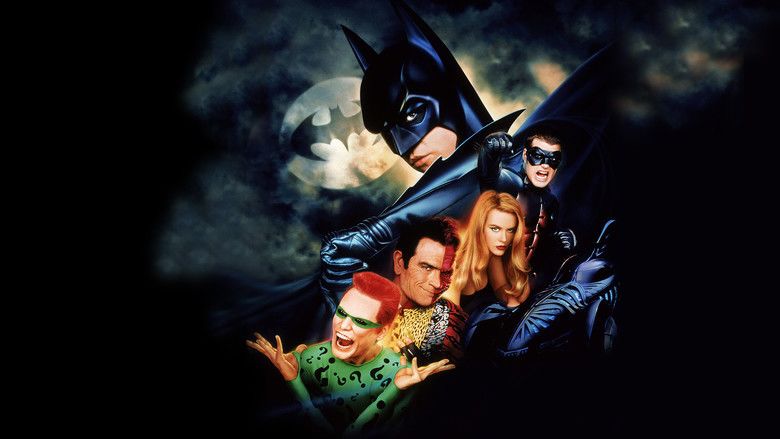
After coming across the journal of his father, he starts questioning his act of vengeance. Bruce struggles with his dual identity as a crime fighter, becoming romantically involved with Dr. Chase Meridian. Michael Keaton, the actor that portrayed Batman in the first two films, was originally attached to reprise his role, but he declined after learning that Schumacher would direct the film. Keaton later recalled, "I knew it was in trouble when [Schumacher] said, ‘Why does everything have to be so dark?’" Ramsey Ellis plays a young Bruce Wayne.
Once a circus acrobat, Dick is taken in by Bruce after Two-Face murders his parents and brother at a circus event. Bruce is reminded of when his parents were murdered when he sees the same vengeance in Dick, and decides to take him in as his ward. He eventually discovers the Batcave and learns Bruce's secret identity. In his wake, he becomes the crime fighting partner, Robin.
A psychologist and love interest of Bruce Wayne. Chase is fascinated by the dual nature of Batman. She is held as a damsel in distress in the climax.
Formerly the good district attorney of Gotham City, half of Harvey's face is scarred with acid during the conviction of a crime boss. Driven insane, he becomes the criminal Harvey Two-Face obsessed with killing Batman. He flips a two-headed coin to determine if he kills (damaged side) or not (clean side). Billy Dee Williams, the actor that portrayed Dent in the first film, was supposed to reprise the role, but Joel Schumacher gave the role to Jones, as he had worked with him previously in The Client.
A former Wayne Enterprises employee, Edward resigns after his newest invention is personally rejected by Bruce Wayne, with whom he is obsessed. He becomes the villainous Riddler, leaving riddles and puzzles at crime scenes. Robin Williams was previously considered for the role, but he declined, although later regretted. Singer Micky Dolenz was also in contention for the role, but he also turned down the offer.
The Wayne family's faithful butler and Bruce's confidant. Alfred also befriends the young Dick Grayson.
The police commissioner of Gotham City.
Two-Face's "good" assistant.
Two-Face's "bad" assistant.
Gotham's top gossip columnist.
The head Doctor of Arkham Asylum. His surname is a reference to Tim Burton, the director of the first two installments. He originally filmed a scene in which Dr. Burton discovered that Two-Face had escaped and found his guard tied up and gagged, but the scene was deleted from the film.
Two-Face's hostage during the opening scene.
Edward Nygma's ill-tempered supervisor at Wayne Enterprises. After Stickley discovers the side effect of Edward's invention, Edward kills him and makes it look like suicide. Begley was uncredited for this role.
This is the first of five cameo appearances in Batman films by Leahy, a United States Senator and DC Comics fan.
Development
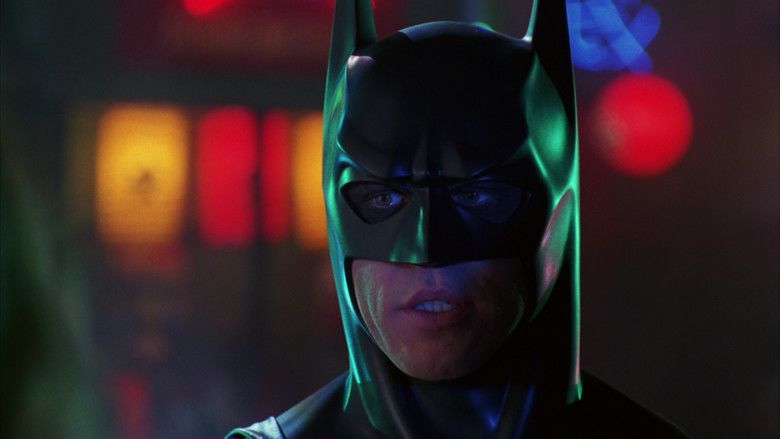
Batman Returns was released in 1992 with financial success and generally favorable reviews from critics, but Warner Bros. was disappointed with its box office run, having made $150 million less than the first film. Director Tim Burton was asked to restrict himself to the role of producer, with approval of Joel Schumacher as director and the husband and wife screenwriting couple Lee and Janet Scott-Batchler, who agreed with him that "the key element to Batman is his duality. And it's not just that Batman is Bruce Wayne". Their original script introduced a psychotic Riddler with a pet rat accompanying him. The story elements and much of the dialogue still remained in the finished film, though Schumacher felt it could be "lighte[ne]d down". Schumacher claims he originally had in mind an adaptation of Frank Miller's Batman: Year One. Warner Bros. rejected the idea as they wanted a sequel, not a prequel, though Schumacher was able to include very brief events in Bruce Wayne's childhood with some events of the comic The Dark Knight Returns. Akiva Goldsman, who worked with Schumacher on The Client, was brought in to rewrite the script. Burton, who was more interested in directing Ed Wood, later reflected he was taken aback by some of the focus group meetings for Batman Forever, a title which he hated. Producer Peter MacGregor-Scott represented the studio's aim in making a film for the MTV Generation with full merchandising appeal.
Production went on fast track with Rene Russo cast as Dr. Chase Meridian but Michael Keaton decided not to reprise Batman because he did not like the new direction the film series was heading in. Keaton also wanted to pursue "more interesting roles", turning down $15 million. A decision was made to go with a younger actor for Bruce Wayne, and an offer was made to Ethan Hawke, who turned it down. Schumacher had seen Val Kilmer in Tombstone, but was also interested in Daniel Day-Lewis, Ralph Fiennes, William Baldwin and Johnny Depp. Kilmer signed on without reading the script or knowing who the new director was.
With Kilmer's casting, Warner Bros. dropped Rene Russo as Chase Meridian. Robin Wright, Jeanne Tripplehorn and Linda Hamilton were all being considered the role was recast with Nicole Kidman. Billy Dee Williams took on the role of Harvey Dent in Batman on the possibility of portraying Two-Face in a sequel, but Schumacher cast Tommy Lee Jones in the role, after having worked with him on The Client. Jones was reluctant to accept the role, but did so after his son's insistence. Robin Williams was in discussions to be the Riddler at one point. In a 2003 interview, Schumacher stated Michael Jackson lobbied hard for the role, but was turned down before Jim Carrey was cast. Robin appeared in the shooting script of Batman Returns but was deleted due to too many characters. Marlon Wayans had been cast in the role, and signed for a potential sequel. It was decided to replace Wayans with a white actor. Leonardo DiCaprio was considered, but decided not to pursue the role after a meeting with Schumacher. Chris O'Donnell was cast and Mitchell Gaylord served as his stunt double. Schumacher attempted to create a cameo role for Bono as his MacPhisto character, but both came to agree it was not suitable for the film.
Filming
Filming started in September 1994. Schumacher hired Barbara Ling for production design, claiming that the film needed a "force" and good design. Ling could "advance on it". Schumacher wanted a design that was not to be in any way connected to the previous films, and instead was to be inspired by the images from the Batman comic books seen in the 1940s/early 1950s and taken from that of New York City architecture in the 1930s, with a combination of modern Tokyo. He also wanted a "city with personality", with more statues, as well as various amounts of neon.
Schumacher had problems filming with Kilmer, whom he described as "childish and impossible", reporting that he fought with various crewmen, and refused to speak to Schumacher during two weeks after the director told him to stop behaving in a rude way. Schumacher also mentioned Tommy Lee Jones as a source of trouble: "Jim Carrey was a gentleman, and Tommy Lee was threatened by him. I'm tired of defending overpaid, overprivileged actors. I pray I don't work with them again." Carrey later acknowledged Jones was not friendly to him, telling him once off-set during the production, "I hate you. I really don't like you ... I cannot sanction your buffoonery."
Design and effects
Rick Baker designed the prosthetic makeup. John Dykstra, Andrew Adamson and Jim Rygiel served as visual effects supervisors, with Pacific Data Images also contributing to visual effects work. PDI provided a computer-generated Batman for complicated stunts. For the costume design, producer Peter MacGregor-Scott claimed that 146 workers were at one point working together. Batman's costume was redesigned along the lines of a more "MTV organic, and edgier feel" to the suit. Sound editing and mixing was supervised by Bruce Stambler and John Levesque, which included trips to caves to record bat sounds. A new Batmobile was designed for Batman Forever, with two cars being constructed, one for stunt purposes and one for close-ups. Swiss surrealist painter H.R. Giger provided his version for the Batmobile but it was considered too sinister for the film.
Music
Elliot Goldenthal was hired by Schumacher to compose the film score before the screenplay was written. In discussions with Schumacher, the director wanted Goldenthal to avoid taking inspiration from Danny Elfman, and requested an original composition. The film's promotional teaser trailer used the main title theme from Elfman's score of 1989's Batman.
The soundtrack was commercially successful, selling almost as many copies as Prince's soundtrack to the 1989 Batman film. Only five of the songs on the soundtrack are actually featured in the movie. Hit singles from the soundtrack include "Hold Me, Thrill Me, Kiss Me, Kill Me" by U2 and "Kiss from a Rose" by Seal, both of which were nominated for MTV Movie Awards. "Kiss from a Rose" (whose video was also directed by Joel Schumacher) reached No. 1 in the U.S. charts as well. The soundtrack itself, featuring additional songs by The Flaming Lips, Brandy (both songs also included in the film), Method Man, Nick Cave, Michael Hutchence (of INXS), PJ Harvey, and Massive Attack, was an attempt to (in producer Peter MacGregor-Scott's words) make the film more "pop".
Deleted scenes
Batman Forever went through a few major edits before its release. Originally darker than the final product, the movie's original length was closer to 2 hours and 40 minutes according to director Joel Schumacher. There was talk of an extended cut being released to DVD for the film's 10th anniversary in 2005. While all four previous Batman films were given special edition DVD releases on the same day as the Batman Begins DVD release, none of them were given extended cuts, although some of the following scenes were in a deleted scenes section in the special features.
There was an undercurrent theme involving Bruce having repressed memories of an aspect of his parents' death that he hadn't faced which was finding his father's diary on the night of his parents' wake and reading that Bruce insisted his parents go to the theater so he could watch one of the shows, meaning the reason he became Batman was out of the guilt that he killed them.
Many scenes were filmed but deleted from the film, other scenes had footage removed. These included:
Box office
Batman Forever opened in 2,842 theaters in the United States on June 16, 1995, making $52.8 million in its opening weekend, breaking Jurassic Park's record for highest opening weekend gross of all-time (it was surpassed two years later by The Lost World: Jurassic Park's $72.1 million). The film went on to gross $184 million in North America, and $152.5 million in other countries, totaling $336.53 million. The film earned more money than its predecessor Batman Returns, and was the second-highest (behind Toy Story) grossing film of 1995, in the U.S.
Critical reaction
On Rotten Tomatoes, the film has an approval rating of 40% based on 58 reviews, with an average rating of 5.1/10. The site's critical consensus reads, "Loud, excessively busy, and often boring, Batman Forever nonetheless has the charisma of Jim Carrey and Tommy Lee Jones to offer mild relief." On Metacritic, the film has a score of 51 out of 100, based on 23 critics, indicating "mixed or average reviews". Audiences polled by CinemaScore gave the film an average grade of "A–" on an A+ to F scale.
Peter Travers said "Batman Forever still gets in its licks. There's no fun machine this summer that packs more surprises." However, he criticized the film's excessive commercialism and felt that "the script misses the pain Tim Burton caught in a man tormented by the long-ago murder of his parents" seeing the Bruce Wayne of Kilmer as "inexpressive". Brian Lowry of Variety believed "One does have to question the logic behind adding nipples to the hard-rubber batsuit. Whose idea was that supposed to be anyway, Alfred's? Some of the computer-generated Gotham cityscapes appear too obviously fake. Elliot Goldenthal's score, while serviceable, also isn't as stirring as Danny Elfman's work in the first two films."
James Berardinelli enjoyed the film. "It's lighter, brighter, funnier, faster-paced, and a whole lot more colorful than before." Scott Beatty felt "Tommy Lee Jones played Harvey Dent as a Joker knock-off rather than a multi-layered rogue." Lee Bermejo called Batman Forever "unbearable". Gene Siskel and Roger Ebert both gave the film mixed reviews, but with the former giving it a thumbs up and the latter a thumbs down. In his written review, Ebert wrote: "Is the movie better entertainment? Well, it's great bubblegum for the eyes. Younger children will be able to process it more easily; some kids were led bawling from Batman Returns where the PG-13 rating was a joke." Mick LaSalle had a mixed reaction, concluding "a shot of Kilmer's rubber buns at one point is guaranteed to bring squeals from the audience."
Accolades
At the 68th Academy Awards, Batman Forever was nominated for Cinematography (lost to Braveheart), Sound Mixing (Donald O. Mitchell, Frank A. Montaño, Michael Herbick and Petur Hliddal; lost to Apollo 13) and Sound Editing (John Leveque and Bruce Stambler) (also lost to Braveheart). "Hold Me, Thrill Me, Kiss Me, Kill Me" by U2 was nominated for the Golden Globe Award for Best Original Song (lost to "Colors of the Wind" from Pocahontas), but was also nominated for the Worst Original Song Golden Raspberry Award (lost to "Walk Into the Wind" from Showgirls). At the Saturn Awards, the film was nominated for Best Fantasy Film (lost to Babe), Make-up (lost to Seven), Special Effects (lost to Jumanji) and Costume Design (lost to 12 Monkeys). Composer Elliot Goldenthal was given a Grammy Award nomination. Batman Forever received six nominations at the 1996 MTV Movie Awards, four of which were divided between two categories (Carrey and Lee Jones for Best Villain; and Seal's "Kiss from a Rose" and U2's "Hold Me" in Best Song from a Movie). However, it won in just one category—Best Song from a Movie for Seal's "Kiss from a Rose".
Merchandising
In addition to a large line of toys and action figures from Kenner, the McDonald's food chain released several collectibles and mugs to coincide with the release of the film. Peter David and Alan Grant wrote separate novelizations of the film. Dennis O'Neil authored a comic book adaptation, with art by Michal Dutkiewicz.
Six Flags Great Adventure theme park re-themed their "Axis Chemical" arena, home of the Batman stunt show, to resemble "Batman Forever", and the new show featured props from the film. Because of the mostly negative critical reaction however, the stunt arena was changed back to its original version after the season. Six Flags Over Texas featured a one-time fireworks show to promote the movie, and replica busts of Batman, Robin, Two-Face, and the Riddler can still be found in the Justice League store in the Looney Tunes U.S.A. section.
Batman forever 9 10 movie clip batman and robin partner up 1995 hd
Batman forever 5 10 movie clip superhero gig 1995 hd
References
Batman Forever WikipediaBatman Forever IMDbBatman Forever Rotten TomatoesBatman Forever MetacriticBatman Forever themoviedb.org
